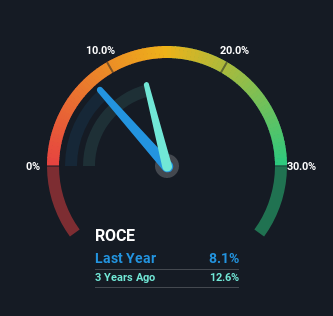- United States
- /
- Semiconductors
- /
- NasdaqGS:CSIQ
Canadian Solar (NASDAQ:CSIQ) Is Looking To Continue Growing Its Returns On Capital

There are a few key trends to look for if we want to identify the next multi-bagger. In a perfect world, we'd like to see a company investing more capital into its business and ideally the returns earned from that capital are also increasing. Ultimately, this demonstrates that it's a business that is reinvesting profits at increasing rates of return. So when we looked at Canadian Solar (NASDAQ:CSIQ) and its trend of ROCE, we really liked what we saw.
Return On Capital Employed (ROCE): What Is It?
If you haven't worked with ROCE before, it measures the 'return' (pre-tax profit) a company generates from capital employed in its business. To calculate this metric for Canadian Solar, this is the formula:
Return on Capital Employed = Earnings Before Interest and Tax (EBIT) ÷ (Total Assets - Current Liabilities)
0.081 = US$302m ÷ (US$8.7b - US$4.9b) (Based on the trailing twelve months to September 2022).
Thus, Canadian Solar has an ROCE of 8.1%. In absolute terms, that's a low return and it also under-performs the Semiconductor industry average of 15%.
Check out our latest analysis for Canadian Solar

Above you can see how the current ROCE for Canadian Solar compares to its prior returns on capital, but there's only so much you can tell from the past. If you'd like, you can check out the forecasts from the analysts covering Canadian Solar here for free.
What Can We Tell From Canadian Solar's ROCE Trend?
Even though ROCE is still low in absolute terms, it's good to see it's heading in the right direction. The data shows that returns on capital have increased substantially over the last five years to 8.1%. The company is effectively making more money per dollar of capital used, and it's worth noting that the amount of capital has increased too, by 128%. The increasing returns on a growing amount of capital is common amongst multi-baggers and that's why we're impressed.
In another part of our analysis, we noticed that the company's ratio of current liabilities to total assets decreased to 57%, which broadly means the business is relying less on its suppliers or short-term creditors to fund its operations. So this improvement in ROCE has come from the business' underlying economics, which is great to see. However, current liabilities are still at a pretty high level, so just be aware that this can bring with it some risks.
In Conclusion...
A company that is growing its returns on capital and can consistently reinvest in itself is a highly sought after trait, and that's what Canadian Solar has. And investors seem to expect more of this going forward, since the stock has rewarded shareholders with a 86% return over the last five years. Therefore, we think it would be worth your time to check if these trends are going to continue.
If you'd like to know about the risks facing Canadian Solar, we've discovered 1 warning sign that you should be aware of.
For those who like to invest in solid companies, check out this free list of companies with solid balance sheets and high returns on equity.
New: AI Stock Screener & Alerts
Our new AI Stock Screener scans the market every day to uncover opportunities.
• Dividend Powerhouses (3%+ Yield)
• Undervalued Small Caps with Insider Buying
• High growth Tech and AI Companies
Or build your own from over 50 metrics.
Have feedback on this article? Concerned about the content? Get in touch with us directly. Alternatively, email editorial-team (at) simplywallst.com.
This article by Simply Wall St is general in nature. We provide commentary based on historical data and analyst forecasts only using an unbiased methodology and our articles are not intended to be financial advice. It does not constitute a recommendation to buy or sell any stock, and does not take account of your objectives, or your financial situation. We aim to bring you long-term focused analysis driven by fundamental data. Note that our analysis may not factor in the latest price-sensitive company announcements or qualitative material. Simply Wall St has no position in any stocks mentioned.
About NasdaqGS:CSIQ
Canadian Solar
Provides solar energy and battery energy storage products and solutions in in Asia, the Americas, Europe, and internationally.
Moderate with reasonable growth potential.

